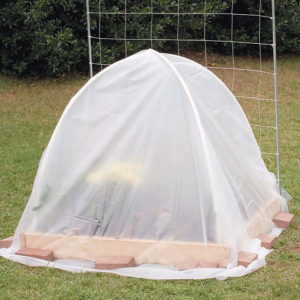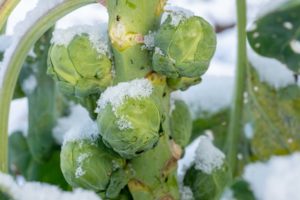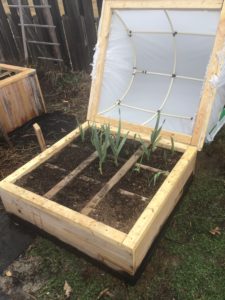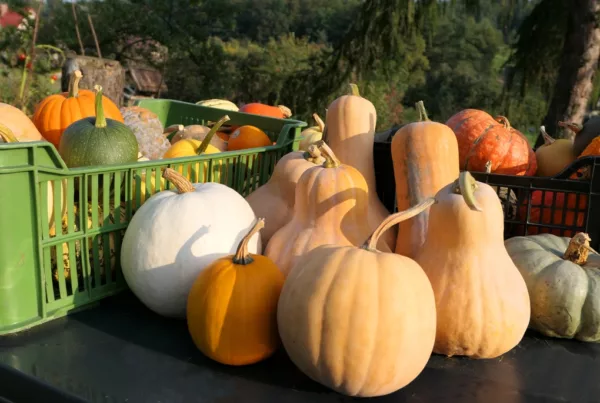Written by Chris McLaughlin
Hoop houses and cold frames are a must-have for the devoted gardener. They work much like an unheated greenhouse by extending your growing season both in early spring and late fall.
Hoop houses placed over your SFG heat up your Mel’s Mix™ faster, which means you can get veggie seeds and starts in your beds during the first chilly weeks of spring. That same protective cover will have you harvesting vegetables longer into the fall, as well. And no matter the season, a hoop house is a perfect spot to harden off indoor-grown seedlings transitioning to outdoor life.
Even a winter garden is a possibility, depending on your growing zone, with a hoop house or a cold frame. You’ll find more cold frame tips from Mel himself on page 89 of the All New Square Foot Gardening 3rd edition. You can enjoy cool season crops such as lettuce, spinach, arugula, bok choy, scallions, carrots, parsnips, turnips, celeriac, kale, cabbage, beets, rutabaga, Swiss chard, leeks, broccoli, and Brussels sprouts in your SFG with the help of a hoop house or cold frame.
DIY Hoop House – Here’s How!

Create a tool-free hoop house with pre-cut PVC pipe
A hoop house can easily be built onto your existing Square Foot Garden bed. You’ll need:
- ½” PVC pipe – PVC pipe length (they will cut it at the hardware store) should be at least 1.5 times the width of the bed so that you get a nice arch over the bed. Don’t over-arch, however, or it may collapse under the weight of snow.
- Metal PVC clamps to secure the PVC pipe to the bed
- 4-8 mil thick UV-resistant polyethylene film
- Bricks, rocks, or wood
- Plastic hoop house clips – These snap on or clip along the hoop to keep everything in place. They are not necessary, but nice to have.
Using metal PVC clamps, arch the PVC pipe and secure at regular intervals about (4 feet apart) along both sides of your SFG bed frame. Once the arches are in, run another PVC pipe along the top of the arches as a support; attach it with twist ties, heavy duty tape or twine. Lay the polyethylene film over all of the arches, covering the bed completely. If you have plastic hoop house clips, these can be locked over the plastic film and onto the arches to help secure the poly. Use the bricks, rocks, or wood to secure the extra plastic length to the ground.
I leave the PVC arches attached to my garden beds and simply remove the poly covering in the warm months. If your SFG is on the smaller side, you may opt to construct a portable hoop house by constructing a separate frame with the hoops and plastic permanently attached. Instead of the hoops being attached to your SFG, this type is placed over the bed (like a mesh bug cover over picnic dishes) when it’s needed and stored away during the warm months.
Hoop House Pro Tips
- Have your hoop house ready well before your area’s first frost date.
- It may be cold outside, but don’t forget to water! Your SFG is a raised bed and may not absorb enough water due to being covered by a hoop house.
- On warm days, fold back the plastic cover during daytime so plants don’t roast.
- If temps are above 60, vent by pulling back a bit of the cover.
- Mulch with dry, shredded leaves or straw as added insulation.
- Once you’re deep into winter, you can add more insulation by placing a floating row cover over the hoop house to protect plants.
Remember – A Little Frost Won’t Hurt

A little frost actually boosts the flavor of brassicas
Did you know some winter vegetables are better after a little frost? During the winter, plants convert starch into sugar to help protect themselves from the winter cold. Frost triggers some vegetables like carrots, parsnips, turnips, celeriac, kale, cabbage, beets, rutabaga, Swiss chard, leeks, broccoli, and Brussels sprouts to produce even higher amounts of sugar. While this process is nature’s design to protect plants, the by-product is extra flavor for us!
Learn more about the Square Foot Gardening Method by taking the introductory course.




